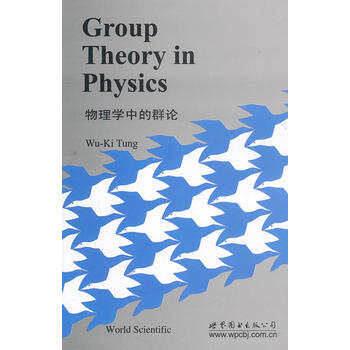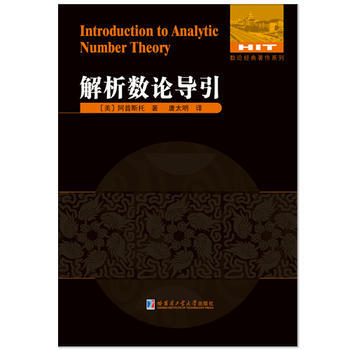
具體描述
基本信息
書名:物理學中的群論
:49.00元
作者:(美)吳基東
齣版社:世界圖書齣版公司
齣版日期:2011-01-01
ISBN:9787510029554
字數:
頁碼:
版次:1
裝幀:平裝
開本:24開
商品重量:0.440kg
編輯推薦
內容提要
group theory provides the natural mathematical language toformulate symmetry principles and to derive their consequences inmathematics and in physics. the 'special functions' of mathematicalphysics, which pervade mathematical analysis,classical physics, andquantum mechanics, invariably originate from underlying symmetriesof the problem although the traditional presentation of such topicsmay not expressly emphasize this universal feature. moderndevelopments in all branches of physics are putting more and moreemphasis on the role of symmetries of the underlying physicalsystems. thus the use of group theory has bee increasinglyimportant in recent years. however, the incorporation of grouptheory into the undergraduate or graduate physics curriculum ofmost universities has not kept up with this development. at best,this subject is offered as a special topic course, catering to arestricted class of students. symptomatic of this unfortunate gapis the lack of suitable textbooks on general group-theoreticalmethods in physics for all serious students of experimental andtheoretical physics at the beginning graduate and advancedundergraduate level. this book is written to meet precisely thisneed.
there already exist, of course, many books on group theory andits applications in physics. foremost among these are the oldclassics by weyl, wigner, and van der waerden. for applications toatomic and molecular physics, and to crystal lattices in solidstate and chemical physics, there are many elementary textbooksemphasizing point groups, space groups, and the rotation group.reflecting the important role played by group theory in modernelementary particle theory, many current books expound on thetheory of lie groups and lie algebras with emphasis suitable forhigh energy theoretical physics. finally, there are several usefulgeneral texts on group theory featuring prehensiveness andmathematical rigor written for the more mathematically orientedaudience. experience indicates, however, that for most students, itis difficult to find a suitable modern introductory text which isboth general and readily understandable.
目錄
preface
chapter 1 introduction
1.1 particle on a one-dimensional lattice
1.2 representations of the discrete translation operators
1.3 physical consequences of translational symmetry
1.4 the representation functions and fourier analysis
1.5 symmetry groups of physics
chapter 2 basic group theory
2.1 basic definitions and simple examples
2.2 further examples, subgroups
2.3 the rearrangement lemma and the symmetric (permutation)group
2.4 classes and invariant subgroups
2.5 cosets and factor (quotient) groups
2.6 homomorphisms
2.7 direct products
problems
chapter 3 group representations
3.1 representations
3.2 irreducible, inequivalent representations
3.3 unitary representations
3.4 schur's lemmas
3.5 orthonormality and pleteness relations of irreduciblerepresentation matrices
3.6 orthonormality and pleteness relations of irreduciblecharacters
3.7 the regular representation
3.8 direct product representations, clebsch-gordancoefficients
problems
chapter 4 general properties of irreducible vectors andoperators
4.1 irreducible basis vectors
4.2 the reduction of vectors--projection operators for irreducibleponents
4.3 irreducible operators and the wigner-eckart theorem
problems
chapter 5 representations of the symmetric groups
5.1 one-dimensional representations
5.2 partitions and young diagrams
5.3 symmetrizers and anti-symmetrizers of young tableaux
5.4 irreducible representations of sn
5.5 symmetry classes of tensors
problems
chapter 6 one-dimensional continuous groups
6.1 the rotation group so(2)
6.2 the generator of so(2)
6.3 irreducible representations of so(2)
6.4 invariant integration measure, orthonormality and pletenessrelations
6.5 multi-valued representations
6.6 continuous translational group in one dimension
6.7 conjugate basis vectors
problems
chapter 7 rotations in three-dimensional space--the groupso(3)
7.1 description of the group so(3)
7.1.1 the angle-and-axis parameterization
7.1.2 the euler angles
7.2 one parameter subgroups, generators, and the lie algebra
7.3 irreducible representations of the so(3) lie algebra
7.4 properties of the rotational matrices dj(a, fl, 7)
7.5 application to particle in a central potential
7.5.1 characterization of states
7.5.2 asymptotic plane wave states
7.5.3 partial wave deposition
7.5.4 summary
7.6 transformation properties of wave functions andoperators
7.7 direct product representations and their reduction
7.8 irreducible tensors and the wigner-eckart theorem
problems
chapter 8 the group su(2) and more about so(3)
8.1 the relationship between so(3) and su(2)
8.2 invariant integration
8.3 Orthonormality and pleteness relations of dj
8.4 projection operators and their physical applications
8.4.1 single particle state with spill
8.4.2 two particle states with spin
8.4.3 partial wave expansion for two particle scattering withspin
8.5 differential equations satisfied by the dj-functions
8.6 group theoretical interpretation of spherical harmonics
8.6.1 transformation under rotation
8.6.2 addition theorem
8.6.3 deposition of products of yim with the samearguments
8.6.4 recursion formulas
8.6.5 symmetry in m
8.6.6 Orthonormality and pleteness
8.6.7 summary remarks
8.7 multipole radiation of the electromagic field
problems
chapter 9 euclidean groups in two- and three-dimensionalspace
9.1 the euclidean group in two-dimensional space e2
9.2 unitary irreducible representations of e2--theangular-momentum basis
9.3 the induced representation method and the plane-wavebasis
9.4 differential equations, recursion formulas,and additiontheorem of the bessel function
9.5 group contraction--so(3) and e2
9.6 the euclidean group in three dimensions: e3
9.7 unitary irreducible representations of e3 by the inducedrepresentation method
9.8 angular momentum basis and the spherical bessel function
problems
chapter 10 the lorentz and poincarie groups, and space-timesymmetries
10.1 the lorentz and poincare groups
10.1.1 homogeneous lorentz transformations
10.1.2 the proper lorentz group
10.1.3 deposition of lorentz transformations
10.1.4 relation of the proper lorentz group to sl(2)
10.1.5 four-dimensional translations and the poincare group
10.2 generators and the lie algeebra
10.3 irreducible representations of the proper lorentz group
10.3.1 equivalence of the lie algebra to su(2) x su(2)
10.3.2 finite dimensional representations
10.3.3 unitary representations
10.4 unitary irreducible representations of the poincaregroup
10.4.1 null vector case (pu= 0)
10.4.2 time-like vector case (c1>3 0)
10.4.3 the second casimir operator
10.4.4 light-like case (c1 = 0)
10.4.5 space-like case (c1<0)
10.4.6 covariant normalization of basis states and integrationmeasure
10.5 relation between representations of the lorentz and poincaregroups--relativistic wave functions, fields, and waveequations
10.5.1 wave functions and field operators
10.5.2 relativistic wave equations and the plane waveexpansion
10.5.3 the lorentz-poincare connection
10.5.4 'deriving' relativistic wave equations
problems
chapter 11 space inversion invariance
11.1 space inversion in two-dimensional euclidean space
11.1.1 the group 0(2)
11.1.2 irreducible representations of 0(2)
11.1.3 the extended euclidean group e2 and its irreduciblerepresentations
11.2 space inversion in three-dimensional euclidean space
11.2.1 the group 0(3) and its irreducible representations
11.2.2 the extended euclidean group e3 and its irreduciblerepresentations
11.3 space inversion in four-dimensional minkowski space
11.3.1 the plete lorentz group and its irreduciblerepresentations
11.3.2 the extended poincare group and its irreduciblerepresentations
11.4 general physical consequences of space inversion
11.4.1 eigenstates of angular momentum and parity
11.4.2 scattering amplitudes and electromagi
用戶評價
評分
評分
評分
評分
評分
評分
評分
評分
相關圖書
本站所有内容均为互联网搜索引擎提供的公开搜索信息,本站不存储任何数据与内容,任何内容与数据均与本站无关,如有需要请联系相关搜索引擎包括但不限于百度,google,bing,sogou 等
© 2025 book.tinynews.org All Rights Reserved. 静思书屋 版权所有














![湖沼學:內陸水生態係統 [加拿大] 卡爾夫 高等教育齣版社 pdf epub mobi 電子書 下載](https://pic.tinynews.org/28228448969/5afa6eb7Necebfdf0.jpg)






